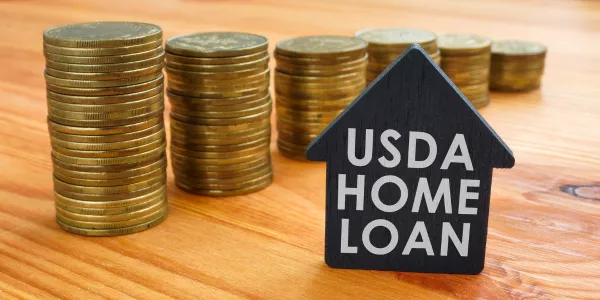Living in a rural area certainly brings a quiet and unique experience, very different from the busy life in urban settings. Especially nowadays, when people are looking for a retreat into nature, purchasing a home in these areas can bring substantial satisfaction and financial benefits. That’s when a USDA-backed loan comes onto the scene.
The key factor in securing a USDA home loan is ensuring that the property you're interested in is situated in an area that meets the program's eligibility criteria. Here we will learn about specifics of USDA loans, including their workings, qualification requirements, how to locate homes eligible for such loans, and the overall process of obtaining a USDA home loan.
Understand USDA homes for sale and their eligibility criterias
USDA (United States Department of Agriculture) homes for sale refer to properties eligible for purchase under the USDA's Rural Development housing programs. These programs aim to assist families and individuals in acquiring, building, or repairing homes in rural areas. USDA loans are not only for buying or constructing homes but also extend to renovating, improving, or relocating a house within a qualifying region.
A crucial criterion for the home to be qualified for USDA Loans is that the home must serve as the borrower's main residence. Properties intended for investment, rental, vacation, or as a secondary home do not qualify. Also,the property must meet USDA's standards of being "decent, safe, and sanitary".
This includes having a solid foundation, a reliable roof, accessible road entry, functional heating, cooling, electrical, and plumbing systems, as well as proper well and septic systems if present.
Finding eligible USDA homes for sale
The most effective way to find out if a specific house is eligible for a USDA loan is by utilizing the USDA property eligibility map. This tool allows you to enter the address of a house you're interested in to verify if it falls within a USDA-eligible area.
The map displays different areas with color coding to indicate eligibility. Remember, not every home in an area may qualify for USDA loans due to various factors, including population density.
Before beginning your search, it's advisable to get pre-qualified for a USDA loan. This will give you an idea of what mortgage amount you may qualify for and help you focus your search on a house that suits your budget. The loan application process involves working with a USDA-approved mortgage lender and requires approval from both the lender and the USDA.
Which requirements do I need to meet for a USDA Mortgage Loan?

To qualify for a USDA home loan, check if you are compliant with the requirements, which are:
- Applicants must be U.S. citizens, U.S. non-citizen nationals, or qualified aliens with a valid Social Security number.
- Your home must be located in an eligible rural area, typically defined as a community with a population of less than 20,000.
- Your income should not exceed 115% of the area's median income.
- The total of your monthly mortgage payment, which includes the principal, interest, insurance, and taxes, should be less than 29% of your monthly income.
- The sum of all your monthly debt obligations, inclusive of the mortgage payment you're proposing, should not surpass 41% of your monthly income.
Types of USDA loans

There are two main types of USDA loans designed to support home buying in rural areas:
Guaranteed USDA Loans
Offered through approved mortgage lenders, these loans provide 100% financing to eligible low and moderate-income buyers. They can be used for purchasing, building, remodeling, relocating, or improving a home in qualified rural locations, as verified by the USDA’s eligibility map.
A significant advantage of these loans is the absence of a set limit on the borrowing amount, along with the USDA’s guarantee of up to 90% of the loan. This guarantee allows buyers to make little to no down payment without the requirement for private mortgage insurance (PMI).
Direct USDA Loans
These are directly issued by the USDA and target low and very low-income applicants who might not qualify for conventional mortgages and who currently lack safe and sanitary housing. Direct loans offer payment assistance to reduce the monthly mortgage burden temporarily.
The loans are restricted to primary residences within specified loan limits, which in 2023 range up to $377,600 for most areas and can go as high as $871,400 in certain locations.
Is Rural Development the Same as USDA?
Yes, Rural Development is a term often used interchangeably with USDA when it comes to housing programs. The United States Department of Agriculture (USDA) offers financial aid and support to rural areas, residents, and businesses through its Rural Development program. This initiative is dedicated to fostering growth and sustainability in rural communities.
Differences Between FHA and USDA Loans
USDA and FHA loans are administered by separate government entities, leading to distinct differences in their application processes, underwriting criteria, appraisal guidelines, loan amounts, mortgage insurance requirements, and interest rate offerings. Each loan type adheres to its own set of rules and standards, reflecting the unique objectives and policies of the respective overseeing agencies.
Borrowers with low to moderate incomes often seek mortgage options with more flexible borrowing criteria, particularly regarding down payments and mortgage insurance. This is where USDA and FHA loans become attractive options.
USDA loans are specifically tailored for those interested in buying homes in rural areas and generally cater to lower-income borrowers. In contrast, FHA loans are more accessible to a broader range of borrowers, including those with smaller down payments or lower credit scores, and are not restricted to rural areas. We can highlight some others differences between these loans, like:
| FHA Loans | USDA Loans |
| FHA loans typically require a minimum down payment. | USDA loans often offer the benefit of no down payment |
| FHA loans are designed for low-to-moderate-income borrowers and are not limited to rural areas. | USDA loans are specifically for rural development. |
| FHA loans do not have income restrictions. | USDA loans have maximum income limits which vary by region and family size. |
It’s worth mentioning that USDA and FHA loans are backed by the U.S. Department of Agriculture and the Federal Housing Administration respectively. While these agencies guarantee the loans, they don't issue the loans directly to borrowers. Instead, their role is to provide a safety net for lenders, offering protection against potential losses if a borrower defaults on their loan. Both have an upfront guarantee fee and an annual fee.
What Does USDA Stand For in Real Estate?
In real estate, USDA stands for the United States Department of Agriculture. The term is commonly associated with the USDA's Rural Development Guaranteed Housing Loan Program, which assists eligible buyers in purchasing homes in rural and suburban areas.
People also ask
Is FHA loans better than USDA loans?
Choosing between an FHA and USDA loan largely depends on the individual borrower's situation. USDA loans are typically well-suited for lower-income borrowers looking to purchase homes in rural areas.
On the other hand, FHA loans are often a good fit for those who have a smaller down payment saved and may not have high enough credit scores to secure a low-interest rate on a conventional mortgage. Each type of loan has its unique advantages and is designed to cater to different financial needs and housing situations.
What does the process of searching for USDA property involve?
When searching for USDA properties, the process involves assessing eligibility based on factors such as income limits, property eligibility (like the size and features of the property), and buyer qualifications including credit score and debt-to-income ratio. Most of the United States is eligible for a USDA home loan, with focus primarily on property eligibility and the financial profile of the applicant.
What does the USDA single family housing programs offer?
The USDA's Single Family Housing Programs offer opportunities for individuals and families to buy, build, or repair affordable homes in rural America. These programs are designed to support the vitality of rural communities and vary based on income, providing options such as direct loans, guaranteed loan programs, home repair loans, and grants.
The USDA housing programs reflect the department's commitment to enhancing the quality of life in rural areas by making homeownership more accessible. Whether it's understanding the nuances between USDA and FHA loans or exploring property eligibility for a USDA loan, these programs play a crucial role in supporting rural homebuyers and communities.

 Marcio Vasconcelos
Marcio Vasconcelos





